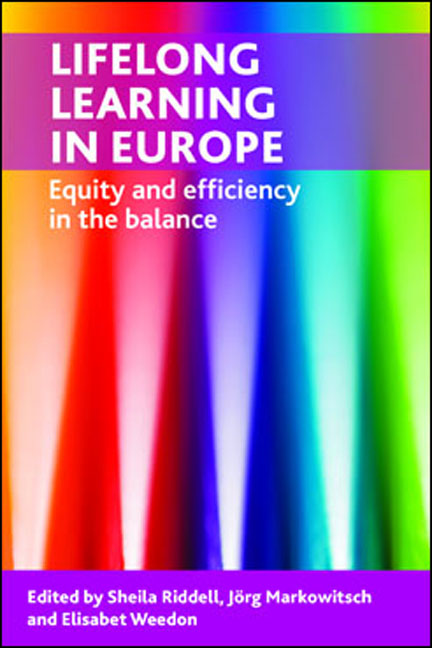Book contents
- Frontmatter
- Contents
- List of figures, tables and case studies
- Notes on contributors
- List of contributors, by country, to the EU Sixth Framework Project ‘Towards a Lifelong Learning Society in Europe: The Contribution of the Education System’ (LLL2010)
- one Lifelong learning and the generation of human and social capital
- two Lifelong learning and the wider European socioeconomic context
- three Neoliberal and inclusive themes in European lifelong learning policy
- four Formal adult education in the spotlight: profiles, motivations and experiences of participants in 12 European countries
- five The sociodemographic obstacles to participating in lifelong learning across Europe
- six The qualification-providing enterprise? Support for formal adult education in small and medium-sized enterprises
- seven Reducing or reinforcing inequality: assessing the impact of European policy on widening access to higher education
- eight Conclusion: the role of lifelong learning in reducing social inequality at a time of economic crisis
- Technical annex to Chapter Four
- Glossary of terms and abbreviations
- Index
Technical annex to Chapter Four
Published online by Cambridge University Press: 01 September 2022
- Frontmatter
- Contents
- List of figures, tables and case studies
- Notes on contributors
- List of contributors, by country, to the EU Sixth Framework Project ‘Towards a Lifelong Learning Society in Europe: The Contribution of the Education System’ (LLL2010)
- one Lifelong learning and the generation of human and social capital
- two Lifelong learning and the wider European socioeconomic context
- three Neoliberal and inclusive themes in European lifelong learning policy
- four Formal adult education in the spotlight: profiles, motivations and experiences of participants in 12 European countries
- five The sociodemographic obstacles to participating in lifelong learning across Europe
- six The qualification-providing enterprise? Support for formal adult education in small and medium-sized enterprises
- seven Reducing or reinforcing inequality: assessing the impact of European policy on widening access to higher education
- eight Conclusion: the role of lifelong learning in reducing social inequality at a time of economic crisis
- Technical annex to Chapter Four
- Glossary of terms and abbreviations
- Index
Summary
Survey methodology
In order to obtain a diverse range of adult learners in our sample, and to guarantee a sufficient number of adult learners at the lowest course levels, each national sample was stratified by ISCED level of the current course, with four subsets of respondents:
• ISCED 1+2 – primary and lower secondary/basic level 250
• ISCED 3 – upper secondary level250
• ISCED 4 – post secondary (non tertiary) level250
• ISCED 5 – tertiary level 250.
Although this sample is not representative of the entire population of adult learners in the formal education system, it allows us to analyse similarities and differences by educational level of the current course. Especially in the Eastern European countries, it was difficult to find 250 respondents at ISCED 1 and 2 levels as the educational provision for early school leavers who want to complete secondary school usually start at ISCED 3 level. Moreover, the aim was to include lowqualified adults in the ISCED 1 and 2 courses, but particularly in Flanders, and also partly in the UK, more highly educated adults were also found on lower level courses. In Flanders, this is because of high enrolments of learners with an ISCED 5 background on arts programmes that span ISCED levels 1 to 4. The database was weighted to take the original sampling structure of 4×250 into account. Each country in the analysis counts 250 adult learners at ISCED 1-2 courses, 250 at ISCED 3 courses, 250 at ISCED 4 courses and 250 at ISCED 5 courses.
In order to exclude students from initial tertiary education, adult learners were not defined on the basis of age, but rather narrowly as people who have left fulltime formal initial education – e.g. to enter the labour market – and who, at some point, decide to participate in formal education again. The time span between leaving full-time formal education and re-entering must be at least two years. Respondents thus had to be adult returners.
The definition of adult education used in this chapter is based on the final report of the task force on the Adult Education Survey (Eurostat, 2007):
Formal education is education provided in the system of schools, colleges, universities and other formal education institutions that normally constitutes a continuous ‘ladder’ of full-time education for children and young people, generally beginning at age of five to seven and continuing up to 20 or 25 years old.
- Type
- Chapter
- Information
- Lifelong Learning in EuropeEquity and Efficiency in the Balance, pp. 163 - 169Publisher: Bristol University PressPrint publication year: 2012



